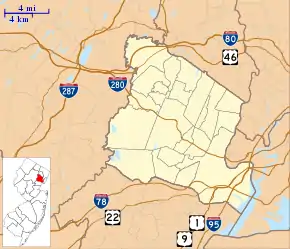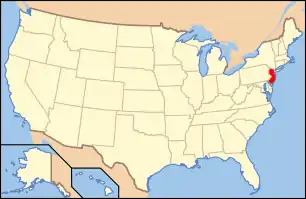Brick Church station
Brick Church is a New Jersey Transit station in East Orange, Essex County, New Jersey, United States, along the Morris and Essex Line. Service is available from this station east to Hoboken Terminal, New York Penn Station and west to Dover and Hackettstown.
Brick Church | |||||||||||||||
|---|---|---|---|---|---|---|---|---|---|---|---|---|---|---|---|
 Looking east toward downtown East Orange | |||||||||||||||
| Platforms | 1 side platform and 1 island platform | ||||||||||||||
| Tracks | 3 | ||||||||||||||
| Connections | |||||||||||||||
| Other information | |||||||||||||||
| Fare zone | 4 | ||||||||||||||
| History | |||||||||||||||
| Opened | November 19, 1836[1] | ||||||||||||||
| Rebuilt | December 1880[2] April 21, 1921–December 18, 1922[3] | ||||||||||||||
| Electrified | September 22, 1930[4] | ||||||||||||||
| Passengers | |||||||||||||||
| 2017 | 2,041 (average weekday)[5][6] | ||||||||||||||
| Services | |||||||||||||||
| |||||||||||||||
| |||||||||||||||
Brick Church Station | |||||||||||||||
 | |||||||||||||||
 | |||||||||||||||
| Location | Brick Church Plaza, East Orange, New Jersey | ||||||||||||||
| Coordinates | 40°45′56″N 74°13′10″W | ||||||||||||||
| Area | 2 acres (0.8 ha) | ||||||||||||||
| Built | 1921 | ||||||||||||||
| Architect | Nies, F.J. | ||||||||||||||
| Architectural style | Tudor Revival, Jacobethan Revival | ||||||||||||||
| MPS | Operating Passenger Railroad Stations TR | ||||||||||||||
| NRHP reference No. | 84002636[7] | ||||||||||||||
| Added to NRHP | June 22, 1984 | ||||||||||||||
There are two transit lines that serve this station -- the Morris & Essex Gladstone and Morris & Essex Morristown. Each weekday, 103 trains pass through the station, including 19 trains during peak hours. During FY2012, the average weekday boardings were about 1,610. This stop was ranked #24 out of 148 commuter rail stations. At this location there are available commuter parking and bike racks for passenger use.[8]
The brick church itself, originally the Second Presbyterian Church of Orange, can be seen north of the station. The church building dates from 1878. The Brick Church station was probably established not long after judging by the architectural style of the original station building. The present station building was opened in December 1922 when the track grade was raised above street level.[9]
Brick Church was the station stop for "the Oranges" made by the Delaware, Lackawanna and Western Railroad's through trains to Buffalo and the west. Its priority continues to this day under NJ Transit, Brick Church having more train service than either Orange or East Orange.
The head house has been on the state and federal registers of historic places since 1984,[10] listed as part of the Operating Passenger Railroad Stations Thematic Resource.[11]
History
The line that currently runs through East Orange began in 1835 with the charter of the Morris and Essex Railroad, being approved by the New Jersey State Legislature on January 29.[12] Service through the city of East Orange began on November 19, 1836 from Newark to The Oranges. With the construction of the railroad, Matthias Ogden Halstead (1792–1866), a local property developer took advantage of the one train a day that went to Newark. The railroad dropped Halstead off at his house and picked him up at his house rather making a trip to a station. Halstead offered at no cost to build a proper station at the site of the Brick Church station, and did so for the railroad.[13]
Station layout

The station has two low-level platforms serving all three tracks.
| P Platform level |
Side platform, doors will open on the right | |
| Track 3 | ← Morristown Line toward Dover or Hackettstown (Orange) ← Gladstone Branch toward Gladstone (Orange) | |
| Track 1 | ← Morristown Line toward Dover or Hackettstown (South Orange) ← Gladstone Branch toward Gladstone (South Orange) Morristown Line and Gladstone Branch toward Hoboken or New York (East Orange) → | |
| Island platform, doors will open on the left or right | ||
| Track 2 | Morristown Line and Gladstone Branch toward Hoboken or New York (East Orange) → | |
| G | Street level | Station building, ticket machines, parking |
See also
Bibliography
- Douglass, A.M. (1912). The Railroad Trainman, Volume 29. Cleveland, Ohio: Brotherhood of Railroad Trainmen. Retrieved April 3, 2020.
- New Jersey State Board of Assessors (1888). Annual Report of the State Board of Assessors of the State of New Jersey, Volumes 4-5. Camden, New Jersey: S. Chew, Printer. Retrieved April 3, 2020.
- Taber, Thomas Townsend; Taber, Thomas Townsend III (1980). The Delaware, Lackawanna & Western Railroad in the Twentieth Century. 1. Muncy, PA: Privately printed. ISBN 0-9603398-2-5.CS1 maint: ref=harv (link)
- Whittemore, Henry (1896). The Founders and Builders of the Oranges. Newark, New Jersey: L.J. Hardham. Retrieved April 3, 2020.
References
- Douglass 1912, p. 339.
- "A new depot has been erected..." The Montclair Times. December 4, 1880. p. 3. Retrieved February 18, 2020 – via Newspapers.com.

- "D., L. & W. Opens New Elevated Line". The Paterson Evening News. December 18, 1922. p. 1. Retrieved March 5, 2019 – via Newspapers.com.

- "Edison Pilots First Electric Train Over Orange-Hoboken Route". The Passaic Daily News. September 22, 1930. p. 5. Retrieved January 31, 2021 – via Newspapers.com.

- "QUARTERLY RIDERSHIP TRENDS ANALYSIS" (PDF). New Jersey Transit. Archived from the original (PDF) on December 27, 2012. Retrieved January 4, 2013.
- "How Many Riders Use NJ Transit's Hoboken Train Station?". Hoboken Patch. Retrieved 2018-07-18.
- "National Register Information System". National Register of Historic Places. National Park Service. March 13, 2009.
- http://www.njfuture.org/wp-content/uploads/2012/09/Targeting-Transit-sample-station-area-profile.pdf
- Taber & Taber 1980, p. 8
- Monmouth County Listings, National Register of Historic Places. Accessed September 2, 2007.
- Brick Church New Jersey Transit Railroad Station Survey
- New Jersey State Board of Assessors 1888, p. 58.
- Whittemore 1896, p. 407.
External links
![]() Media related to Brick Church (NJT station) at Wikimedia Commons
Media related to Brick Church (NJT station) at Wikimedia Commons
